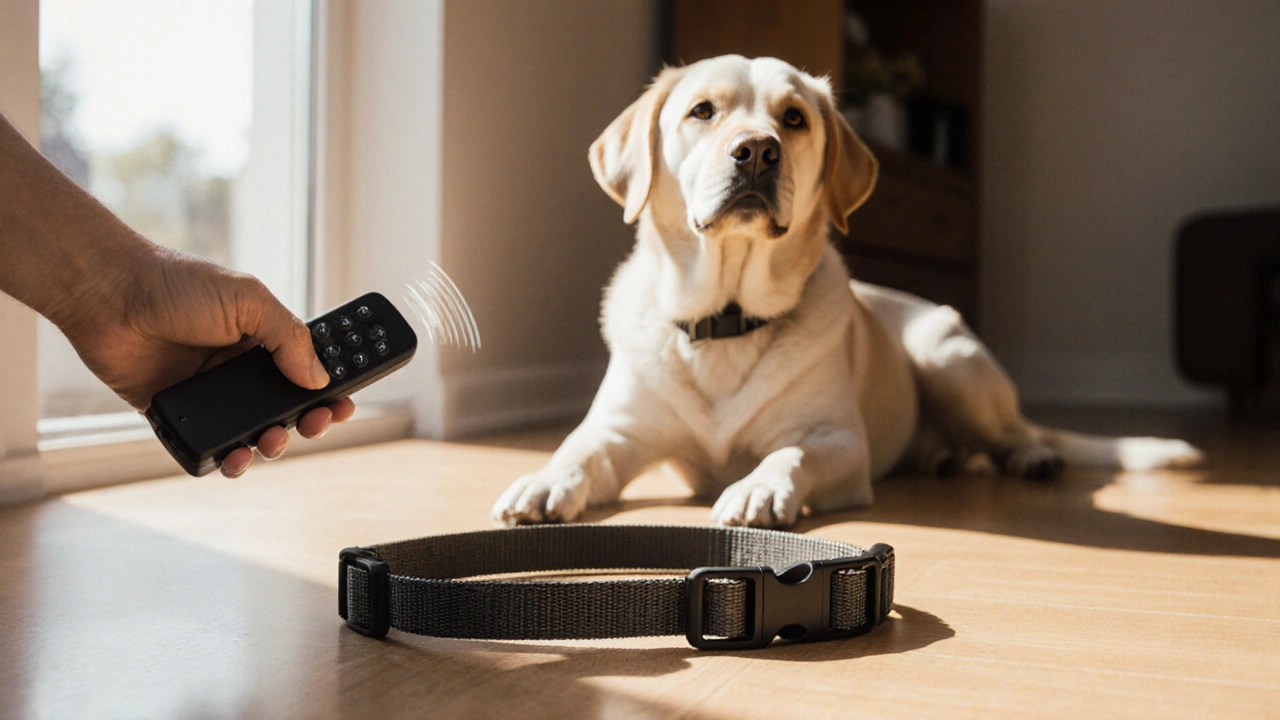Ever wondered if the buzzing sensation from a Vibrating dog collar is a real training solution or just a gimmick? You’re not alone. Millions of owners face the same question when they see a collar that promises a gentle nudge instead of a shock. This article breaks down the tech, looks at the science, weighs the pros and cons, and gives you a clear roadmap for deciding whether a vibrating collar belongs in your dog’s toolbox.
How a Vibrating Collar Works
At its core, a vibrating collar is a small battery‑powered device that wraps around your dog’s neck. When you press a button on the remote or activate a sensor, a motor inside the collar spins rapidly, creating a buzzing vibration that the dog feels on its throat. Most models let you adjust three key parameters:
- Intensity: low, medium, or high levels measured in g‑force (typically 0.5‑2.0 g).
- Pattern: steady buzz, pulsing, or rhythmic bursts.
- Duration: from 1 second up to 5 seconds per activation.
This flexibility is meant to let owners match the stimulus to their dog’s size, temperament, and the specific behavior they’re trying to curb.
What the Science Says
Research on vibrating collars is far less extensive than on traditional shock collars, but a few studies give us useful clues.
American Kennel Club commissioned a 2022 survey of 1,200 dog owners who used vibration, static, or no collar. The findings were clear:
- Owners who used vibrating collars reported a 45 % reduction in leash‑pulling within two weeks.
- Only 8 % of respondents said the vibration caused fear or avoidance behaviors, compared to 22 % for shock collars.
- When paired with Positive reinforcement (treats, praise), effectiveness jumped to 68 %.
Veterinary behaviorist Dr. Sandra Lee published a 2023 case series in the Journal of Applied Animal Welfare Science that tracked 30 dogs with chronic barking. After six weeks of vibratory cues combined with reward‑based training, 70 % showed a meaningful drop in barking frequency, while none displayed increased cortisol levels (a stress hormone marker).
These numbers suggest that vibration can be a useful “attention‑getter,” especially when it’s not the sole method but part of a broader training plan.
Pros and Cons of Using a Vibrating Collar
Every tool has trade‑offs. Below is a quick rundown of the most common advantages and drawbacks you’ll encounter.
| Aspect | Vibrating Collar | Shock Collar | No Collar |
|---|---|---|---|
| Method | Gentle vibration | Electrical pulse | Verbal/hand cues only |
| Risk of Fear | Low (8 % reported) | Higher (22 % reported) | None |
| Training Speed | Moderate | Fast (but less humane) | Slow, depends on owner skill |
| Cost | $30‑$80 | $45‑$150 | Free |
| Legal Restrictions | Rarely banned | Banned in several EU countries | None |
Key takeaways: Vibrating collars sit in a sweet spot-more noticeable than a simple verbal cue but far less aversive than a shock.
When a Vibrating Collar Makes Sense
Not every dog benefits from a collar. Here are three scenarios where the buzzing cue shines.
- Leash pulling: A quick buzz when the leash tightens can interrupt the habit without jerking the dog.
- Recall training: In noisy parks, a vibration can cut through distractions and remind the dog to come back.
- Calming anxious dogs: Some owners find that a low‑intensity buzz mimics a gentle touch, helping dogs settle during thunderstorms or fireworks.
If your dog has a medical neck condition, a collar that applies pressure might be risky-always check with a Veterinarian first.
Alternatives to Vibrating Collars
Before you click “Buy,” consider these other options:
- Standard flat collars with ID tags - cheapest, no stimuli.
- Head halters (e.g., Gentle Leader) - give you direct control of head direction.
- Training harnesses - distribute pull pressure across the chest, reducing neck strain.
- Clicker training - a sound cue paired with treats; works well for precision commands.
Each alternative has its own learning curve, but they’re all compatible with reward‑based methods, which the research community (including Dr. Lee’s work) says are the most humane and effective.

Safety Checklist Before Using a Vibrating Collar
Use this quick list to make sure you’re not putting your pup at risk.
- Choose a collar sized to fit snugly-not tight. You should be able to slip two fingers underneath.
- Start at the lowest intensity; increase only if the dog doesn’t respond.
- Never use the collar for prolonged periods-max 5 seconds per activation, with at least a 30‑second gap.
- Avoid using the collar on puppies under 12 weeks or on dogs with neck injuries.
- Pair every vibration with a positive reward (treat, praise) within 1‑2 seconds.
- Monitor your dog’s body language: ears back, tail tucked, or excessive panting may signal stress.
Choosing the Right Vibrating Collar
Not all collars are created equal. Here’s what to look for when you shop.
| Feature | Why It Matters | Typical Range |
|---|---|---|
| Battery life | More sessions per charge | 4‑12 hours |
| Water resistance | Can be used in rain or baths | IPX5‑IPX7 |
| Range of remote | Flexibility for park training | 30‑150 ft |
| Intensity settings | Customizable for size/temperament | 3‑5 levels |
| Material | Durability and comfort | Neoprene, leather‑free silicone |
Brands such as DogVibe and QuietPup score high on most of these criteria, but always read recent user reviews-software updates can change battery performance overnight.
Putting It All Together
If you’ve made it this far, you probably have a good sense of when a vibrating collar is useful. The bottom line?
- It works best as an attention‑getter, not a punishment.
- Combine it with positive reinforcement for the highest success rate.
- Follow safety guidelines and consult a professional if you’re unsure.
When used responsibly, a vibrating collar can be a gentle nudge that helps your dog learn faster without the fear associated with older shock devices.
Do vibrating collars hurt my dog?
When set to the lowest intensity, the vibration feels like a gentle tap. Most dogs adapt quickly, and studies show a low incidence of stress signs. However, high settings or overuse can cause discomfort, so start low and monitor behavior.
Can I use a vibrating collar on a puppy?
Puppies under 12 weeks have delicate necks and are still learning basic cues. Most experts recommend waiting until they’re at least three months old and have mastered basic obedience before introducing any collar stimulus.
How does a vibrating collar compare to a shock collar?
Both deliver a quick signal, but the shock delivers an electric pulse that many dogs find aversive. The vibrating version provides a milder cue, leading to fewer fear‑based reactions and better compliance when paired with rewards.
Do I need a professional trainer to use a vibrating collar?
Not necessarily, but a trainer can help you integrate the collar into a balanced program. If you’re new to dog training, start with basic commands and reward systems before adding any collar stimulus.
What should I do if my dog shows signs of stress?
Stop using the collar immediately. Look for signs like ears flattened, tail tucked, or excessive panting. Consult a veterinarian or certified behaviorist to rule out underlying anxiety or medical issues.
